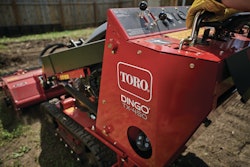
Adding a second battery to 2011 Chevy/GMC 1500 is an easy DIY project
Inverters, coolers, radios, warning strobes, laptops, battery chargers, printers and other necessary accessories put a big drain on any pickup’s stock electrical system when the truck is sitting on a jobsite with the engine off.
Even with the engine running the amp load needed to power such an array of accessories can put a strain on the stock electrical system.
Add a plow, connect to a weak trailer battery or flip on auxiliary driving, fog or work lights and the battery is going to take a hard hit.
In preparation for adding an inverter, warning lights and a few other work truck “necessaries” on Project Bedrock — our 2011 GMC Sierra 1500 Crew Cab 4×4 – we decided it was a good idea to double-up the batteries.
Stock Chevy/GMC 1500s come with a single Group 48 battery located in the passenger’s-side rear corner of the engine bay.
There’s also an unused battery tray on the driver’s front corner; there’s no TP2 (dual-battery option) for the 1500s, so it’s a mystery why it’s there.
 Wiring diagram that comes with the Cole Heresee 48530 Smart battery Isolator lines out the installation.
Wiring diagram that comes with the Cole Heresee 48530 Smart battery Isolator lines out the installation.
Whatever the reason, it does make it easy to double-up the batteries. All you need is a GM Battery Retainer (#14005061) that costs less than $5, a second battery and a battery isolator designed to work with the new electronics.
THE SETUP
The factory AC-Delco Group 48 battery is unique to GM trucks, and it’s rated at 615 CCA (Cold Cranking Amps) with 110 RC (Reserve Capacity).
It’s almost identical to a Group 34/78 or Group 78 battery. So we chose an Odyssey 78-PC1500-A AGM battery as the auxiliary, which delivers 880 CCA and 135 minutes RC.
The Odyssey is far more receptive to deep discharging and resistant to the hard pounding from off-pavement use than the OEM battery.
 We converted our 2011 GMC Sierra 1500 to dual batteries using an Odyssey 78-PC1500-A AGM battery and Cole Hersee Smart Battery Isolator. C/H Low Voltage Disconnect was also installed.
We converted our 2011 GMC Sierra 1500 to dual batteries using an Odyssey 78-PC1500-A AGM battery and Cole Hersee Smart Battery Isolator. C/H Low Voltage Disconnect was also installed.
To connect the two batteries properly, we selected a Cole Hersee Smart Battery Isolator (#48530) designed to work with today’s electronic charging systems.
The 200-amp isolator senses the voltage of both main and auxiliary batteries and connects/separates them according to their charge, always protecting the main “cranking” battery.
SMART ISOLATOR
For example, you pull the truck in to a jobsite, turn the engine off and leave all the warning lights on.
When the isolator senses the batteries reach 12.7V it opens the solenoid relay to separate the two batteries and turns off the status light.
This separation protects the starting battery while allowing the auxiliary battery to continue to power the auxiliary loads.
 The finished installation is clean. Fender corner brace has to be removed to get battery in and out.
The finished installation is clean. Fender corner brace has to be removed to get battery in and out.
When you start the truck, the charging system brings the cranking battery back to 13.2 volts (full charge), then the isolator closes, the red status light turns on and the alternator now recharges the auxiliary battery.
Should you need a “boost” at start, an optional “momentary switch” can be easily wired in to the Smart Isolator that connects both batteries for one minute once it’s activated.
We also installed a Cole Hersee SureStart Compact Low Voltage Disconnect Switch (#48513-01) on the firewall to use as our “hot point” between the auxiliary battery and future strobe lights and accessories.
This unit sounds an alarm when battery voltage drops below 12.1 volts and 60 seconds later it automatically disconnects the battery (we will use it with the auxiliary) from whatever accessories are attached to it.
The switch keeps the battery protected from total discharge when running lights or other accessories for a period of time.
Dual batteries sets Project Bedrock up to handle any electrical need we might encounter in the field. It should work nicely on your Chevy or GMC as well.
MAKING CONNECTIONS
If your shop doesn’t have battery cable crimping tools, consider battery terminal connectors like those used by upscale audio shops. DB Link (dblink.net) is a good source.
They offer several styles of battery terminals that are gold plated so they resist corrosion.
The ports in the terminal are designed to lock stripped cable ends in place with Allen set screws. No crimping necessary. Fast and convenient.
REMOTE JUMPER CABLE
 Having a set of jumper cables that can be plugged in quickly is a nice item to have on a pickup. So we installed Wrangler Power Products i-Light Battery Jumper cable system.
Having a set of jumper cables that can be plugged in quickly is a nice item to have on a pickup. So we installed Wrangler Power Products i-Light Battery Jumper cable system.
This gives us a quick-connect plug-in point at the winch mount for jumpers in case someone else runs their battery down.
The ultra-flexible cables have heavy-duty plugs, and they come with a nifty LED light to show the cables are hooked up correctly at both ends.
The kit, which has a lifetime warranty, is ideal for any pickup used in construction or landscaping. Click here to see how they are installed: Qucik-disconnect jumper cable installation.
SOURCES:
Odyssey Batteries/EnerSys Energy Products Inc.; (800) 538-3627
Cole Hersee; Littlefuse Commercial Vehicle Products: (210) 651-1845
Truck Supply & Outfitters; (205) 553-4203














